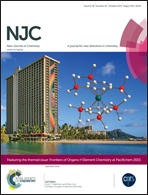In situ thermal synthesis of novel polyimide nanocomposite films containing organo-modified layered double hydroxide: morphological, thermal and mechanical properties
Abstract
An organic–inorganic hybrid compound comprised of a Zn/Al layered double hydroxide (LDH) intercalated with citric acid (LDH–CA) was dispersed in polyimides (PIs) with an N-benzonitrile side group, through in situ polymerization. At first, 3-(bis(4-aminophenyl)amino)benzonitrile as a diamine monomer was synthesised and then it was reacted with 4,4′-benzophenone tetracarboxylicdianhydride via a thermal imidization method to form processable PIs. To improve the thermal and mechanical properties and also to avoid the aggregation of LDH particles in the polymer matrix, a small amount of LDH–CA (1, 2, 4 wt%) was added to the synthesized PI. The resulting materials were characterized by Fourier transform-infrared spectroscopy, X-ray powder diffraction, thermogravimetric analysis (TGA), field emission-scanning electron microscopy, and transmission electron microscopy (TEM) techniques. TEM results showed that the LDH–CA nanolayers were dispersed in PI matrices. The mechanical and thermal properties of the synthesized composites are effectively enhanced by the incorporation of 2 wt% LDH–CA in the polymer matrix. For the PI/LDH–CA nanocomposites, a maximum degree of tensile strength is observed at a LDH–CA loading of 2 wt%, corresponding to an almost 32% increase in tensile strength compared to the pure PI.


 Please wait while we load your content...
Please wait while we load your content...